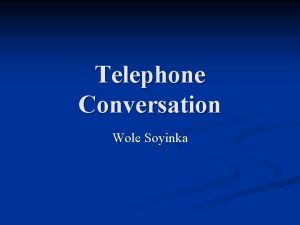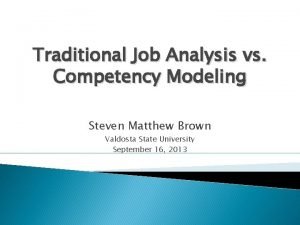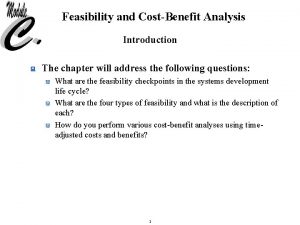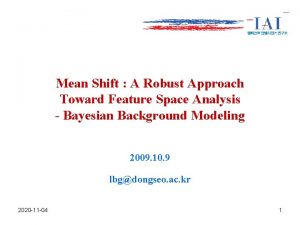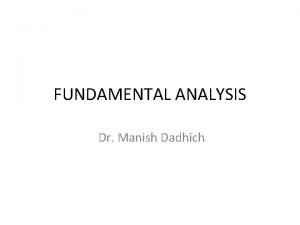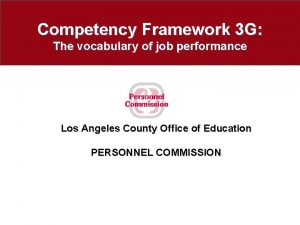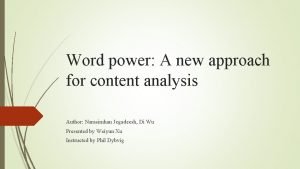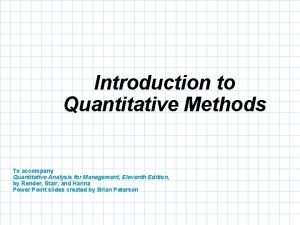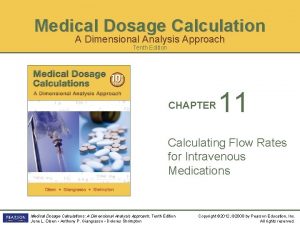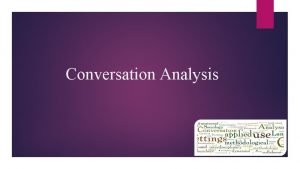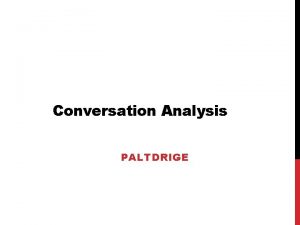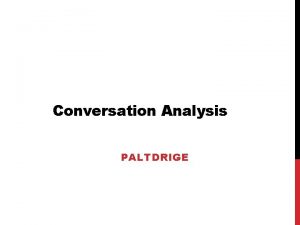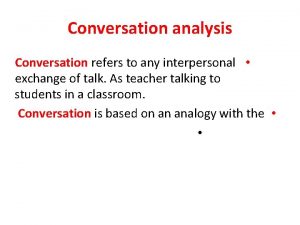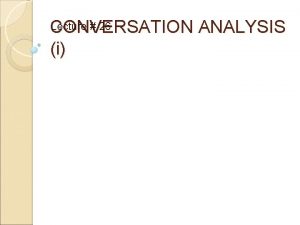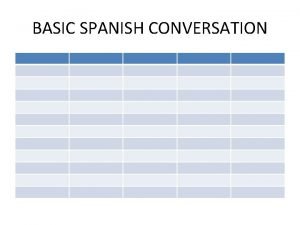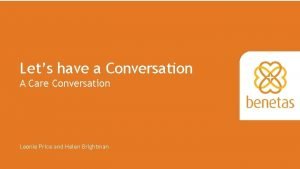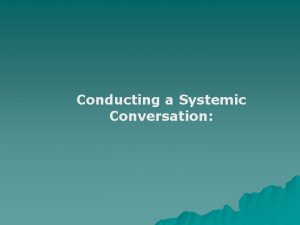CONVERSATION ANALYSIS Conversation analysis CA is an approach






















- Slides: 22

CONVERSATION ANALYSIS

Conversation analysis (CA) is an approach to the study of social interaction, embracing both verbal and non-verbal conduct, in situations of everyday life. CA originated as a sociological method, but has since spread to other fields. CA began with a focus on casual conversation, but its methods were subsequently adapted to embrace more task- and institution-centered interactions, such as those occurring in doctors' offices, courts, law enforcement, helplines, educational settings, and the mass media. CA was developed in the late 1960 s and early 1970 s principally by the sociologist Harvey Sacks and his close associates Emanuel Schegloff and Gail Jefferson.

The actions that make up conversations are implemented through turns at talk, and turn-taking is therefore a fundamental feature of conversational organization. The analysis of how turn-taking works focuses on two major issues: 1) what turns are; and 2) how these turns are allocated between speakers. Turns are sentences, clauses, phrases or single words that can be recognized as units in their own right depending on context. A crucial feature of these units is that they are projectable: that is, a hearer can recognize what it will take for a unit to be complete. The allocation of turns between speakers is implemented through a hierarchically organized set of rules: i) If the current speaker selects a next one to speak at the end of the current turn (by name, gaze or contextual aspects of what is said), the selected speaker has the right and obligation to speak next. ii) If the current speaker does not select a next speaker, other potential speakers have the right to self-select (the first starter gets the turn), iii) if options i and ii have not been implemented, current speaker may continue with another turn. At the end of that turn, the option system applies again.

CONVERSATION ANALYSIS Silences: Pause: A period of silence within a speaker's turn. Gap: A period of silence between logical parts of turns. Lapse: A period of silence when no sequence is in progress: the current speaker stops talking, does not select a next speaker, and no one self selects. Lapses are commonly associated with visual or other forms of disengagement between speakers, even if these periods are brief. Rules of conversations: 1) speakers wanting a long turn, for example to tell a story or describe important news, must use some form of preface to get a go-ahead that provides that others will refrain from intervening during the course of the telling 2) conversations cannot be appropriately terminated by 'just stopping', but require a special closing sequence

DISCOURSE MARKERS A Discourse Marker (DM) is a word or phrase that functions primarily as a structuring unit of spoken language. To the listener, a DM signals the speaker's intention to mark a boundary in discourse (framing move). DMs are active contributions to the discourse and signal such activities as: ü change of a speaker, ü taking or holding control of the turn, ü relinquishing control of the turn, ü the beginning of a new topic. We consider as DMs only those instances that structure the discourse and do not carry separate meaning.

Examples: –That gets on my nerves, too. Anyway, tell me about your new job. **** –A: So, how do you make this soup? B: First you take a couple of carrots and chop them. Okay. And then you fry them in butter. actually basically anyway and yeah I mean let's see like oh now DMs Some common okay see so well you know you see you know what I mean

It can sometimes be difficult to distinguish when a word or phrase is functioning as a discourse marker and when it is acting as a content word or a filler. Anyway, let’s change the topic. He will go there anyway. I trust him. He promised to help me… Ok. Forget about it, anyway…

Exercise 1. Identify the discourse markers and explain the role they have. CONTEXT: We want to launch our web site by Thursday. D. : Also, we need to optimize the site's speed. F. : So… that needs to be done before that time? Um… D. : Okay, I want you to settle everything by Wednesday midnight. F. : Wow! So soon? M. : OK, I'll do the database. F. : So! What you are saying is that we have to have everything ready by then, right? D. : Admittedly, I think it's better to be ready before the weekend. Task: think about some turns containing discourse markers with different functions

Exercise 2. Choose the correct discourse marker: 1. …………… nurses are overworked and underpaid. • In particular, Broadly speaking, For instance, Except for 2. I don’t believe in ghosts. …………. . I haven’t seen one yet. Thus, At least, In other words, That is to say 3. I think he should be acquitted. ………… he is too young to know the difference between right and wrong. • After all, Well, Honestly, I suppose 4. The man was sleeping soundly on the river bank. ………… a crocodile was creeping closer. • Despite this, As a result, Meanwhile, By contrast 5. The child didn’t get any medical attention. …………, she died soon after. • Despite this, As a result, In this case, In spite of this



INSERT EXPANSIONS A Can I get a vodka? B Are you twenty-one? A No B No A: How did it go? B: --> What do you mean? To be continued…

POST-EXPANSIONS designed not to project further sequence but to close a sequence found after both preferred and dispreferred responses examples: “oh” indicates change-of-state from unknowing to knowing (i. e. , speaker has gained new information in prior turn) “okay” indicates acceptance “That’s good” indicates stance towards response

DO CONVERSATION ANALYSIS Karen: Brent might learn a little lesson if his security camera got stolen. Hank: Yeah. Karen: By someone. Hank: Hmm. Karen: Someone he trusts. Hank: Yeah, I suppose. Karen: Someone he would never suspect. Hank: Yeah. Karen: Plot the camera's motion and approach from a blind spot. You could pull it off. A: Are you coming tonight? B: Can I bring a guest? A: Male or female? B: What difference does that make? A: An issue of balance. B: Female. A: Sure. B: I’ll be there.


Self-Repair and Other-Repairs are variously classified as 'self-repair' (corrections, etc. made by speakers themselves responsible) vs. 'other-repair' (made by their interlocutors) 'self-initiated' (made by a speaker without querying or prompting) vs. 'other-initiated' (made in response to querying or prompting).

Types of Repair Sequences • Self-initiated self-repair: Repair is both initiated and carried out by the speaker of the trouble source. • Other-initiated self-repair: Repair is carried out by the speaker of the trouble source but initiated by the recipient. • Self-initiated other-repair: The speaker of a trouble source may try and get the recipient to repair the trouble--for instance if a name is proving troublesome to remember. • Other-initiated other-repair: The recipient of a trouble source turn both initiates and carries out the repair. This is closest to what is conventionally called 'correction. '“ Cordelia Chase: I just don't see why everyone's always picking on Marie-Antoinette. I can so relate to her. She worked really hard to look that good, and people just don't appreciate that kind of effort. And I know the peasants were all depressed. Xander Harris: I think you mean oppressed. Cordelia Chase: Whatever. They were cranky. (Charisma Carpenter and Nicholas Brendon in "Lie to Me. " Buffy the Vampire Slayer, 1997)

A linguistic repair may be marked by a hesitation and an editing term (such as, "I mean") and is sometimes regarded as a type of dysfluency. Examples • "Well, I think it’s--you know, I think this has gone beyond, as it were, Al Qaida as a specific network. I mean, this is-there is no central command in this ideology, the way that, you know, you would normally describe one unit of--that leads an operation. It’s not like that. "(Former British Prime Minister Tony Blair, CNN interview, Dec. 8, 2008) • "We don't really move. I mean, we'd like to, but my mom is sort of attached to the house. Attached is, I guess, not the right word. She's pretty much wedged in. " (Johnny Depp as Gilbert in What's Eating Gilbert Grape, 1993) • "If I need to stand up in front of an audience and give a speech and it's an audience full of educated people from all walks of life, then I would feel embarrassed about not using correct grammar. I wouldn't want to stand in front and say, 'She don't. . . ' or "He don't. . ' I wouldn't want to say that. But the thing is that I say it so much that it's like I know I would say it at a time that I probably shouldn't say it. But the thing is that what I try to do is when I say that in certain circles, I try to correct myself and I find myself thinking in the middle of my sentences, 'What word do I say next? Which verb agreement am I supposed to use? '" (Reia, quoted by Sonja L. Lanehart in Sista, Speak!: Black Women Kinfolk Talk About Language and Literacy. University of Texas Press, 2002) • Make up short dialogues to demonstrate different types of repair.

The Cooperative Principle The ‘rules ‘ of conversation were first formulated by the Paul Grice (1975) as the Cooperative Principle. This states that we interpret the language on the assumption that a speaker is obeying the four maxims (known as Grice’s Maxims) of: 1 QUALITY (BEING TRUE) 2 QUANTITY (BEING BRIEF) 3 RELATION (BEING RELEVANT) 4 MANNER (BEING CLEAR) Conversational implicature Grice argues that although speakers, usually choose to co-operate, they can also refuse to abide by that principle, or, in other words, flout it. If a maxim is deliberately broken, it is normally done so to achieve a very specific effect and communicate a specific meaning, known as a conversational implicature, in other words, the special meaning created when a maxim is flouted.

Are the maxims flouted or violated? If they are flouted, what is the implicature? 1. A: “Would you like to go out with Beatrice? ” B: “Is the Pope Catholic”? 2. A: “So tell me, do you like what I did to my hair? B: “Er. . . what’s on TV tonight? ” 3. A: “So what color are you painting your house? ” B: “The walls are going to be off-white to contrast with the black sofa and Regency armchairs that I inherited from my great-aunt. (Bless her soul, she passed away last year after a long but distressing marriage to a man who really wasn’t able to appreciate her extraordinary love of the visual and performing arts. ) Then the trim will be peach except near the door, which Alice said should be salmon because otherwise it will clash with the yellow, black, and red Picasso print that I brought back from Spain–I vacationed in Spain in August of, let’s see, 2002, and I bought it then. Or was it July? I forget, actually, Gosh! Time goes fast, don’t you think? Oh, never mind. And the stairway leading to the bedrooms will be a pale yellow. . . ”

• 4. A: “Would you like to hear my rendition of ‘Feelings’? ” • B: “Yes, of course. I’d love to. ” [it’s actually the last thing you want to hear] • 5. A: “Tony is one of the cheapest people I know. ” • B: “Yeah, he’s someone who never parts with a dime” • 6. A: “How are your son and daughter doing? ” • B: “Cindy is in her second year of med school–she’s doing fine. ” [silence follows] • 7. A: I might win the lottery. • B: Yes, and pigs might fly.

8. A: “You’re soaked! It must be raining pretty hard outside. ” B: “You’re a regular Sherlock Holmes. ” 9. A: “Hmmmm, I thought I left my watch in my desk drawer before I left for Spring Break. ” B: “Well I definitely didn’t take it. Absolutely not. There’s no way I would take someone else’s property. Besides, I already have my own watch. And I would never steal from someone, never. ” 10. A: “I wonder why Dave didn’t answer the phone. I know he’s home. ” B: “ER is on. ” 11. A: “Let’s stop and get something to eat. The kids must be hungry. ” B: “Okay, but not M-C-D-O-N-A-L-D-S. ” 12. A: “Hey, Kenny! What are you reading? ” B: “A book. ” [abrupt silence] 13. A: “Kathy’s cooking tonight. ” B: “Better stock up on Alka Seltzer. ” 14. A: “So here we are–look up. That’s the Sear’s tower. ” B: “That’s an awfully small building!”
 Congratulation logo
Congratulation logo Datagram approach and virtual circuit approach
Datagram approach and virtual circuit approach Theoretical models of counseling
Theoretical models of counseling Waterfall vs shower approach
Waterfall vs shower approach Multiple approach-avoidance conflict
Multiple approach-avoidance conflict Bandura's reciprocal determinism
Bandura's reciprocal determinism Research approach definition
Research approach definition Traditional approach to system development
Traditional approach to system development Deep learning approach and surface learning approach
Deep learning approach and surface learning approach Wole soyinka telephone conversation analysis
Wole soyinka telephone conversation analysis Insertion sequence linguistics example
Insertion sequence linguistics example Job analysis and competency models
Job analysis and competency models Creeping commitment approach to feasibility analysis
Creeping commitment approach to feasibility analysis A robust approach toward feature space analysis
A robust approach toward feature space analysis Eic approach of fundamental analysis
Eic approach of fundamental analysis Traditional job analysis vs competency approach
Traditional job analysis vs competency approach Which risk analysis approach makes use of ale?
Which risk analysis approach makes use of ale? Word power: a new approach for content analysis
Word power: a new approach for content analysis What are structured analysis tools?
What are structured analysis tools? Case tools are limited to systems analysis.
Case tools are limited to systems analysis. A modern approach to systems analysis and design
A modern approach to systems analysis and design Quantitative analysis for management excel qm
Quantitative analysis for management excel qm Medical dosage calculations 10th edition
Medical dosage calculations 10th edition









